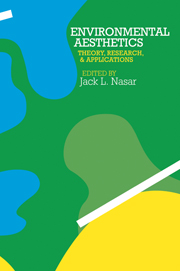Book contents
- Frontmatter
- Contents
- List of figures
- List of tables
- List of contributors and participants
- Acknowledgments
- Preface
- Section I Theory
- Section II Empirical studies
- Editor's introduction
- A Methodological comments
- B Architectural interiors
- C Architectural exteriors
- D Urban scenes
- E Natural and rural scenes
- Section III Applications
- References
- Index of authors
- Subject index
Editor's introduction
Published online by Cambridge University Press: 05 September 2013
- Frontmatter
- Contents
- List of figures
- List of tables
- List of contributors and participants
- Acknowledgments
- Preface
- Section I Theory
- Section II Empirical studies
- Editor's introduction
- A Methodological comments
- B Architectural interiors
- C Architectural exteriors
- D Urban scenes
- E Natural and rural scenes
- Section III Applications
- References
- Index of authors
- Subject index
Summary
The design of buildings, the cityscape, or the landscape has the potential to evoke favorable or unfavorable responses from the public. Without detracting from the role of a skilled designer, empirical researchers have attempted to advance knowledge of such environmental influences on affect. Ultimately, such information can be used to guide design decisions and to produce solutions that are pleasing to users.
Included in this section are studies of interior spaces (Locasso; Kasmar; Flynn), architectural exteriors (Hershberger; Hershberger and Cass; Oostendorp and Berlyne; Groat), central-business-district scenes (Nasar), housing scenes (Nasar; Talbot), retail-street scenes (Nasar), natural scenes (Fenton; Herzog; Nasar, Julian, Buchman, Humphreys, and Mrohaly), and rural scenes (Orland; Kaplan and Herbert), as well as methodological papers that apply to a variety of settings (Fenton and Reser; Russell). In addition, several of these studies (Nasar; Orland; Kaplan and Herbert) provide cross-cultural and intergroup comparisons of aesthetic preferences.
For convenience, the papers are grouped into five categories: (A) methodological comments; (B) architectural interiors; (C) architectural exteriors; (D) urban scenes; and (E) natural and rural scenes. Nevertheless, the studies show considerable agreement on some aspects of environmental preference. These conceptual links are briefly outlined here for dimensions of environmental affect (referring more to subjective feelings in response to the scene), dimensions of environmental perception and cognition (referring more to visual properties of the scene), and the relationship between these two sets of factors.
- Type
- Chapter
- Information
- Environmental AestheticsTheory, Research, and Application, pp. 101 - 104Publisher: Cambridge University PressPrint publication year: 1988



